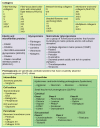The Functional Role of Extracellular Matrix Proteins in Cancer
- PMID: 35008401
- PMCID: PMC8750014
- DOI: 10.3390/cancers14010238
The Functional Role of Extracellular Matrix Proteins in Cancer
Abstract
The extracellular matrix (ECM) is highly dynamic as it is constantly deposited, remodeled and degraded to maintain tissue homeostasis. ECM is a major structural component of the tumor microenvironment, and cancer development and progression require its extensive reorganization. Cancerized ECM is biochemically different in its composition and is stiffer compared to normal ECM. The abnormal ECM affects cancer progression by directly promoting cell proliferation, survival, migration and differentiation. The restructured extracellular matrix and its degradation fragments (matrikines) also modulate the signaling cascades mediated by the interaction with cell-surface receptors, deregulate the stromal cell behavior and lead to emergence of an oncogenic microenvironment. Here, we summarize the current state of understanding how the composition and structure of ECM changes during cancer progression. We also describe the functional role of key proteins, especially tenascin C and fibronectin, and signaling molecules involved in the formation of the tumor microenvironment, as well as the signaling pathways that they activate in cancer cells.
Keywords: collagen; extracellular matrix; fibronectin; matrikines; matrix metalloproteinases; tenascin; tumor microenvironment; tumor progression.
Conflict of interest statement
The authors declare no conflict of interest.
Figures




References
Publication types
LinkOut - more resources
Full Text Sources

